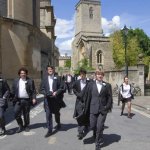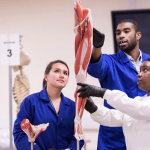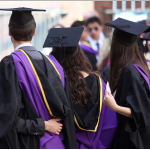Top universities ‘incredibly slow’ to take more disadvantaged students – report
 By Emmanuel Akinwotu From The Guardian UK
By Emmanuel Akinwotu From The Guardian UK
• Study of England’s leading universities finds only marginal increases in access for students from disadvantaged backgrounds
• LSE’s use of ‘contextualised data’ highlighted for its No1 ranking
England’s leading universities have made “incredibly slow” progress in widening access to students from disadvantaged backgrounds, despite spending hundreds of millions of pounds on schemes designed to widen access to their undergraduate courses.
A new report by the independent thinktank Reform ranks 29 “high-tariff” universities for their progress in accepting disadvantaged students. It finds that only the best-performing university, the London School of Economics (LSE), managed to increase its proportion of disadvantaged students by more than one percentage point annually during the period of assessment, 2011-15.
St George’s, University of London, the worst-performing university of those ranked, was one of four institutions where the proportion of disadvantaged students admitted either decreased or flat-lined.
“Overall, English universities have increased access for disadvantaged students – but this progress is skewed towards lower- and middle-tier universities,” said Emilie Sundorph, the report’s lead author. “Among the top universities, progress is incredibly slow. This really matters because universities have a role in ensuring that, regardless of a young person’s background, they have a chance of achieving the benefits associated with the most competitive degrees.”
Across all of England’s leading universities, when state school students from disadvantaged backgrounds achieve grade parity with their most affluent state school counterparts, the number of disadvantaged students admitted is still five percentage points lower, on average.
Reform’s report is concerned by the concentration at the bottom of its ranking of universities with particularly high levels of access spending. In 2015, Oxford University only admitted 85 students from disadvantaged backgrounds, the same number as in 2011, despite spending the most annually (£1,053 per student) on widening participation programmes over that period.
But the report also notes that some universities already accepted a relatively higher proportion of disadvantaged students in 2011, leaving them with less room for improvement: “For example, Lancaster University may not have increased its proportion of disadvantaged students by much, but over the four years it has consistently beaten its benchmark. This has been achieved despite Lancaster only spending £319 per student, far below the group median of £437 and the group mean of £476.”
Contextualised data is king
LSE’s extensive use of “contextualised data” on the background of prospective students is identified as a key driver for its success in broadening admissions.
“While the students we admit have got the same grade across the board, fundamentally we’re only making offers to students who meet the [access] criteria,” said Cath Baldwin, LSE’s head of admissions. “These processes are designed to identify disadvantaged students who have a lower chance of getting in, but who get the same A-level grades.”
These processes identify disadvantaged students who have a lower chance of getting in, but who get the same A-level grades
Cath Baldwin
According to Baldwin, LSE’s admissions team is now fully centralised, and consists of a small team of assessors all trained in implicit bias. “If an applicant has a number of widening participation flags and we’re going to reject them, we have to look extremely carefully on why they are not of the quality required.”
The report calculates that if other universities made the same progress as LSE did in 2015/16 alone, more than 3,500 extra students from widening participation programmes would be admitted to the top 29 universities.
Baldwin said the proportion of students admitted by LSE from the Polar3 quintile 1 group (the lowest on the measure of disadvantage currently used by the Higher Education Funding Council for England) has spiked in the last two years. “We won’t have any major analysis of their performance until after these students have finished, but preliminary results show they are on a par with other students at LSE.”
One of the common explanations for universities not reducing their entry barriers in order to widen access is that these students may struggle to keep up with their counterparts on the course. Despite some mixed evidence on this, the Reform report concludes that universities can contextualise admissions and widen participation by providing lower A-level entry offers without putting these students’ chances of succeeding at risk.
While LSE’s progress in improving access has not included making variable offers to disadvantaged applicants, other universities such as King’s College London (KCL) have recently embraced this policy.
“K-Plus”, one of the widening participation programmes run by KCL since 2016, uses contextualised data to target students in ethnic groups that are underrepresented in universities. According to Syreeta Allen, KCL’s head of widening participation, students who complete the academic assessments are given variable offers up to two grades below the standard offer, so that an AAA A-level offer could be reduced to ABB.
The heart of this issue is there are students of great potential who are not getting the A-level grades
Alan Rusbridger
“We look at contextualised data on factors like geography and free school meals,” Allen said, “but we also look at race and ethnic groups, such as Caribbean students and white working class boys where access has traditionally been unrepresentative. Most students on K-Plus will have multiple indicators.”
Oxford University’s Lady Margaret Hall (LMH) began a one-year foundation programme last year, admitting 10 students – seven of whom were subsequently awarded an undergraduate place at LMH.
“This isn’t a backdoor route of entry – it is still a rigorous progress,” said Alan Rusbridger, former editor of the Guardian who became principal of the college in 2015. “At the heart of this issue is that there are students of great potential who are not getting the A-level grades. When you look beyond those measures, however, there are contextual explanations.”
LMH’s programme will run for at least four years, admitting students who show two or more forms of disadvantage – and who must still achieve just one A-level grade lower across the entry requirement.
According to Rusbridger, other colleges at Oxford have shown interest in the programme, with a wider inquiry also set up by the university on improving access to disadvantaged groups.
“In an admissions system as devolved as in Oxford’s, it’s hard to devise a scheme across all colleges that is fair – and fairness becomes a loaded philosophical term,” he said. “But efforts to deal with these inequalities are growing at Oxford, and hopefully a lot more can be done.”
Slow progress
In January 2016, David Cameron made a speech on “life chances” that was meant to signal a step change in efforts to open up opportunities for poorer and less privileged Britons. “I want every young person in Britain to know that they will be judged according to merit, not inaccurate and lazy stereotypes,” he declared.
Widening access to higher education was a big part of that strategy. Cameron demanded that universities double their proportion of entrants from disadvantaged backgrounds by 2020 – from the 2009 level of 13.6% – and sought to increase the number of black and minority ethnic (BME) students by 20% over the same period.
The then-prime minister also pledged to make access to Britain’s universities, businesses and public-sector organisations fairer by adopting name-blind applications – a process designed to eradicate unconscious bias among those assessing the candidates.
Last year, six English universities – Winchester, Exeter, Huddersfield, Liverpool, Manchester and Leeds – began trialling name-blind admissions to assess the impact on offer rates to specific groups of students.
The university admissions body, Ucas, is expected to release its findings on whether the policy has improved access rates for different ethnic and socio-economic groups soon. An earlier fact-finding report said it would not be feasible for Ucas to mask applicants’ names centrally, because “this would impair universities and colleges’ ability to maintain relationships with students, and undermine efforts to widen participation”.
In 2014-15, 65% of private school students entered one of the top third of England’s universities, compared to 23% of state school students – a gap that has grown over the past few years.
The Reform report is particularly critical of the Office for Fair Access (Offa), the body created in 2004 under New Labour to try to ensure that universities being permitted to raise their tuition fees to £3,000 a year would focus on widening access.
Offa, which will be incorporated into the new Office for Students in January 2018, has never used its powers to fine or sanction universities that failed to reasonably improve access for under-represented groups, despite the limited success of several top universities.
Offa’s chairman Les Ebdon defends the progress universities have made since 2004, while conceding the gap is still very wide. “We’ve actually seen a narrowing of inequality at universities’ admissions,” Ebdon said. “You’re nearly six times more likely to go to a higher-tier university if you’re affluent than if you are from a poorer background – however, it used to be almost seven times.”
The report cites experts who claim that some universities regard spending on widening participation as a “tax”. Ebdon refutes these claims, but admitted there has been an issue of accountability for access spending: “When I started in 2012, some universities didn’t do research on how the impact of spending affected intake. There are still universities who are not doing enough in evaluating their expenditure, but mainly they are doing that more and more.”
According to Ebdon, “We’re moving in the right direction – but we need to do even more. Where you were born or the colour of your skin shouldn’t make an impact on the opportunities available to you – but the evidence is they still do matter.”
A Department for Education spokesperson pointed to Ucas data for 2016 which “shows young people from disadvantaged backgrounds are 43% more likely to go to university compared with 2009/10. [But] of course we are still working to close the gap further between those from the most and least advantaged backgrounds.”
Angela Rayner MP, Labour’s shadow secretary of state for education, said: “This report shows that, despite the rhetoric, this government is failing to improve university access for disadvantaged young people. While admissions rates are stagnant, the rate at which disadvantaged students drop out of university is continuing to rise.”
A spokesman for St George’s, University of London, said: “We feel this report does not reflect our significant work in this area, as it only uses one metric for measuring success in widening participation. We do well in BME student numbers – having 45.6% non-white UK students – and over 30% of our young, first-degree entrants are from low socio-economic classes.
“Unlike other universities listed in the report, we are a small specialised institution and medical students make up a high proportion of our undergraduate population – 36%. As is common across the sector for medicine programmes, we have found it particularly challenging to widen access to medicine due to very high academic entry requirements and a multiple stage admissions process.”
IMAGES:
Students graduate from the London School of Economics, the best-performing university in the new ‘widening access’ ranking. Photograph: Bloomberg via Getty Images
David Cameron delivers a speech on life chances in 2016. Photograph: Andy Rain/EPA
In 2015 Oxford University admitted 85 students from disadvantaged backgrounds. Photograph: Martin Argles for the Guardian
Medical students at St George’s, University of London. Photograph: Dave Guttridge/St George’s
Students graduate from the London School of Economics, the best-performing university in the new ‘widening access’ ranking. Photograph: Bloomberg via Getty Images
For more on this story go to: https://www.theguardian.com/inequality/2017/sep/05/top-universities-incredibly-slow-to-take-more-disadvantaged-students-report








